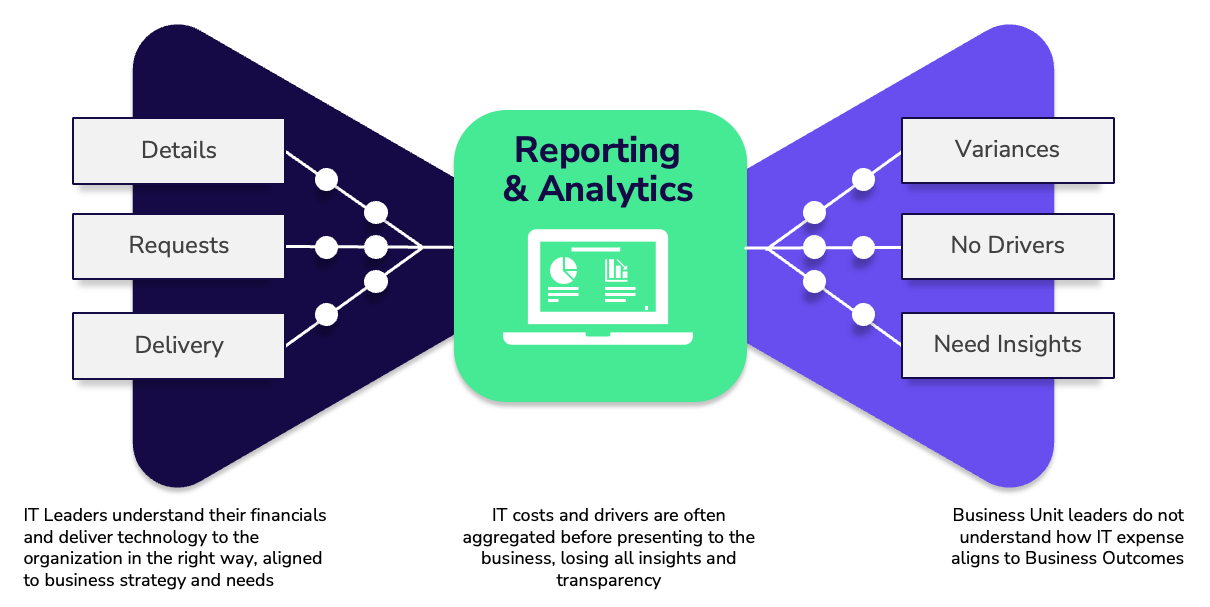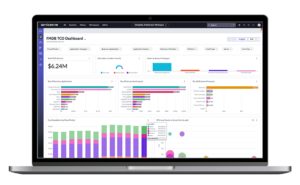In the world of IT financial management, it’s not just understanding your IT costs but the operational detail behind them that drives effective decisions.
The central challenge for many in IT financial management: as IT spend data moves from IT operations to corporate leaders, that crucial detail is often lost.
Called the bowtie effect, it creates a disconnect between IT and the business that negatively impacts decision-making and the credibility of your IT financial management (ITFM) program as a whole.
Below, we explore how the bowtie effect works, why operational detail is critical, and how unraveling the knot can help companies achieve their ITFM goals.
Download your free ITFM/TBM Program Maturity Guide to learn how to take your ITFM program to the next level
What Is the Bowtie Effect?
If you look at how IT spend data is tracked within IT versus how it’s reported out to the business, in many organizations it takes on the shape of a bow tie.
On the left side of the bow tie you have IT teams managing a wealth of detailed information on the specific costs associated with delivering IT services. This granular data is vital for understanding the true cost of IT and making informed decisions around cost optimization. IT Managers know the detail of what each invoice is delivering against. Spend requests are managed in great detail and what IT delivers and why are well defined.
As this data flows through corporate accounting systems, the data is often aggregated and condensed, losing the very detail that made it useful in the first place. What starts as a richly detailed view of IT spend becomes condensed into high-level line items at the center of the bow tie. From there, the expense data is split out by department or business unit for reporting to different corporate leaders, making up the right side of the bow tie. Variances to plan are aggregated and provide little understanding to why. Decision levers for the business to partner with IT are lost and value and insights that align to business strategy are not present.

The Problem with Aggregating IT Spend Data
Aggregating IT spend data gives rise to several problems within the context of ITFM and TBM.
First, it prevents IT from effectively communicating the value of its services to the rest of the business. When financial data is condensed into line-item expenses, it’s difficult to answer questions about changing IT costs because you can’t drill into the operational details behind those expenses.
Why did the budget go up $1 million, even though nothing has seemingly changed? What were those dollars spent on, specifically?
This lack of transparency creates the perception that IT is a black box, where money goes in but nobody knows what comes out.
The second major problem is that this lack of transparency limits the ability of business leaders to make informed decisions in a timely manner. Answering questions can take weeks, with no way of knowing whether the levers you pull will actually reduce costs—or whether they may have unexpected delivery impacts.
The Root Cause of the Bowtie Effect
At the root of the issue are the tools that companies are using to track and report on IT spending.
Those using certain types of ITFM or TBM software may find that it doesn’t combine expenses with operational detail. Here the problem is often that the software simply isn’t built to manage large volumes of data at speed. This requires organizations to link ITFM reporting to corporate accounting systems rather than the general ledger.
Other companies track IT spend data within an IT mega platform like ServiceNow, leveraging applications such as strategic portfolio management (SPM), application portfolio management (APM) or IT asset management (ITAM).
These applications have placeholders for high-level numbers, but again the challenge becomes one of credibility. If anyone challenges where that data came from, IT can’t easily validate the data because they can’t drill down into the operational detail behind it.
Unraveling the Knot to Drive Greater Transparency
So how can organizations unravel the knot at the center of the bow tie to drive credible, responsive and defensible decision-making?
First, you need a cost model linked to the general ledger rather than high-level corporate systems. This is essential to maintaining a detailed, transparent view of IT costs throughout the ITFM process. This, in turn, requires ITFM software like Nicus that’s built to process large volumes of data at speed—not software that forces you to sacrifice detail for performance.
Alternatively, companies tracking IT spending in ServiceNow applications like ITAM, SPM and APM can align reporting with general ledger dollars using Nicus FMDB (financial management database), available in the ServiceNow App Store. This FMDB solution integrates credible data such as unit costs and application TCO with ServiceNow applications teams already use, delivering even more value from investment in the IT mega platform.
In both cases, organizations gain the ability to drill down into the operational detail behind expenses on the spot, so they can make better decisions faster.
Ultimately, preserving this detail is what creates a defensible link between IT spending and business outcomes, opening up the black box to create a more transparent process overall.







